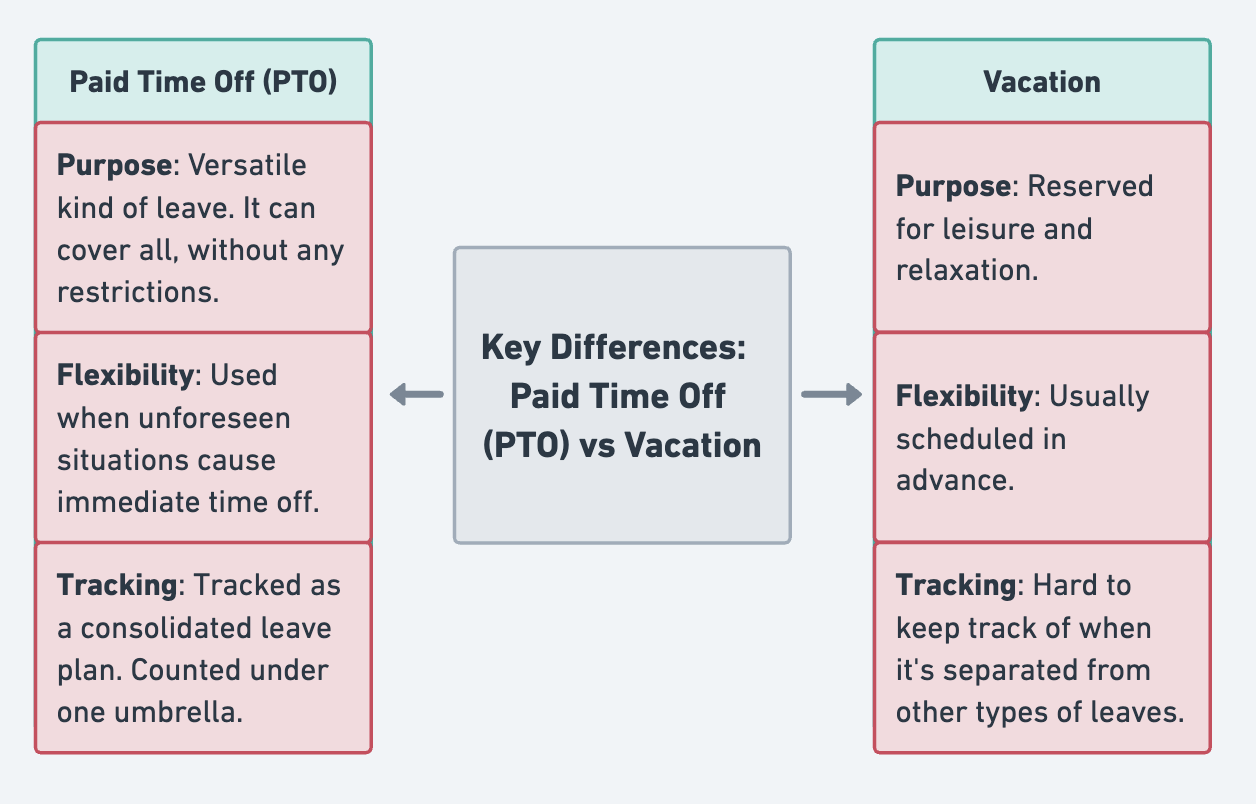30-seconds Paid Time Off vs Vacation summary:
Ever wonder what the difference is between paid time off (PTO) vs vacation?
Did you know that, according to the Bureau of Labor Statistics, only 76% of private industry workers in the U.S. have access to paid vacation?
Did you also know that, 10 days is the average PTO in the United States private sector, excluding paid holidays and sick days?
The following article will help you understand more insights about the real difference between paid time off and vacation.
TABLE OF CONTENTS
- Defining Paid Time Off vs Vacation
- Key Differences between PTO vs Vacation
- PTO Policies: Accrued PTO, Bank of PTO, Unlimited PTO.
- Consolidated vs. Separate Leave Plans
- Time off vs Vacation FAQ
- Time Off vs Vacation Quiz
- Manage Your Employee Leaves With a PTO Tracking Software ✅
Defining Paid Time Off vs Vacation
The terms Paid Time Off (PTO) and Vacation often stand out in the realm of employment benefits. While they might seem interchangeable, they have distinct meanings and implications. Let’s take a look at their definitions:
Paid Time Off (PTO)
- Umbrella Term: PTO encompasses all types of time off, from vacation days to personal days to special leaves.
- No Pay Loss: A primary advantage of PTO is that employees are able to take time off without losing any money. It means while you rest or take care of personal matters, your income stays the same.
- Federal Regulations: In a surprising twist, PTO isn’t governed by any federal law. This means that how it’s accrued and used often depends on company policies or state regulations.
- Consolidated Leave Plan: Companies use consolidated leave plans. With this approach, all types of leaves, like vacations, personal days, and holidays, are bundled into one PTO plan. This makes it easier for employees to track their leaves and gives them more flexibility.
Vacation
- Leisure Time: It’s not the same as PTO, which refers to time off for work-related activities. Vacation is the time to rest, travel, or spend time with friends and family.
- Pre-approval and Scheduling: This pre-approval process ensures that both the employer and employee can plan around this absence. Vacation days aren’t spontaneous. They’re planned ahead of time.
- Not a Mandate: Here’s a surprising fact – employers aren’t legally required to offer paid vacation in most US states. While many do to attract and retain talent, it’s not a given in every workplace.
Employees who want to make the most of their benefits need to understand these definitions, and employers who want to craft policies that are sustainable and competitive.
| Factorial Insight: 55% of Americans don’t use all of their paid time off. |
Key Differences between Paid Time Off vs Vacation
The key differences between Paid Time Off (PTO) and vacation days are the purposes and rules for each. Let’s compare these two types of time off.
Purpose
- PTO: This is a versatile kind of leave. Whether it’s an emergency, a sudden need, or a well-planned vacation, PTO can cover it all. It’s meant to let employees use their time off however they see fit, without any restrictions.
- Vacation: The vacation days are reserved for leisure and relaxation. They’re time to unwind, take a trip, and take a break from your busy schedule.
Flexibility
- PTO: Due to its flexibility, PTO can be used as employees deem necessary since it’s not tied to a specific purpose. This is especially helpful when unforeseen situations cause immediate time off to be needed.
- Vacation: A vacation day, on the other hand, is less flexible. In workplaces where coordination among team members is crucial, it might be harder to get a last-minute vacation leave approved. They are usually scheduled in advance, so teams can manage workloads during an employee’s absence.
Tracking
- PTO: An employee’s PTO is easier to track when the company has a consolidated leave plan. All days off are counted under one umbrella, making it easier to manage for HR departments and employees.
- Vacation: It can be hard to keep track of vacation days if they are kept separate from other types of leaves. Employees might have different quotas for vacation, sick leave, and personal days, each with its own rules.
In conclusion, both PTO and vacation days offer employees valuable time off, but they’re different in their purpose, flexibility, and tracking methods. By understanding these differences, employees and employers can make better decisions about their leaves.
| Factorial Insight: 63% of employees would decline a job offer if it didn’t include PTO. |
PTO Policies
A company’s paid time off (PTO) policy can vary widely, with each one having its own set of advantages and considerations.
Accrued PTO
Employees get PTO days based on how many hours they work or how many days they work. For example, for every month they work full-time, they get one day of PTO. In a proportional system, the more someone works, the more time they get off. It rewards hard work and tenure.
Bank of PTO
Employees get a fixed number of PTO days when they join the company or at the beginning of the year. You can take these days whenever you like. Depending on the company’s policy, unused days might roll over to the next period, get redeemed, or just expire at the end of the year. Employees can plan their leaves strategically with this system because they can see how many days they have left.
Unlimited PTO
While unlimited PTO sounds like a dream come true, it comes with a caveat. Employees have unlimited PTO because they don’t have a maximum limit. They have to do their job responsibilities and make sure their time off doesn’t disrupt the company. Employees are expected to balance work and time off responsibly, and this policy puts a lot of trust in them.
Ultimately, a company’s PTO policy can make a huge difference in its work culture, employee satisfaction, and productivity. Whether it’s the structured approach of accrued PTO, the clarity of a PTO bank, or the flexibility of unlimited PTO, each policy has its own merits and challenges.
| Factorial Insight: 84% of respondents with PTO report they still go to work when ill. |
Consolidated vs. Separate Leave Plans
In order to manage time off, companies often have to decide whether to adopt a consolidated leave policy or keep separate policies for different types of leaves.
Consolidated Plans
- All-inclusive: In consolidated plans, everyone’s leave is counted together, whether it’s vacation, personal days, or anything else. Employees don’t have to juggle between different leave categories when planning their time off because of this holistic approach.
- Flexibility and Ease: There’s a lot of flexibility in a consolidated plan. Employees can take their leave days however they want, without being restricted by specific categories. From an administrative perspective, tracking a single leave quota simplifies management, preventing errors and miscommunications.
Separate Plans
- Distinct Policies: In separate plans, each type of leave has its own rules and quotas. For instance, vacation days have a different accrual rate, usage rules, and carry-over policies than personal days or sick days.
- Potential Dilemmas: Having separate leave plans can be clear by separating different types of leaves, but they can also be challenging. If they’ve exhausted their personal day quota, they might be hesitant to take a personal day off. Instead, they might come to work to save their vacation days, even if that’s not in their best interest. This could lead to burnout and poor job satisfaction.
Overall, the choice between consolidated and separate leave plans depends on your company’s priorities. While consolidated plans are easy to manage and flexible, separate leave plans are more clear and distinguishable. When crafting leave policies, companies should consider their organizational culture and employee needs, as well as the pros and cons of each approach.
Frequently Asked Questions
1. Is it better to use PTO or vacation for a holiday?
Your company’s leave policy and personal preferences can influence whether you use PTO or vacation days. In a company with a consolidated leave plan, the distinction might not matter. If they’re separate, you might want to save vacation days for longer breaks and use PTO for holidays. You should speak to your HR department to understand the implications.
2. Does my company have to provide PTO?
It is not mandatory for companies to provide paid leave in the US. Some states do have specific regulations. Many companies offer PTO as a benefit to retain talent, even if they aren’t legally required to.
3. What happens if I don’t use my PTO or vacation days?
In some companies, unused vacation or PTO days expire at the end of the year. Other companies allow you to carry over unused days or even cash them out. Understand your company’s policy to avoid losing out on valuable time off.
4. How many days off is average in the US?
The average number of paid vacation days offered by private employers after a year is about 10 days, according to the Bureau of Labor Statistics. It tends to increase with tenure. But this is just an average, and it depends on the company and industry a lot.
5. Can I be forced to work during PTO or vacation?
The idea is for employees to have uninterrupted time off during their PTO and vacation days. If you’re constantly asked to work during your time off, it’s worth talking to HR or management about work-life balance. It’s crucial to clarify expectations with your employer before taking time off.
Test Your Knowledge about Paid Time Off vs Vacation Leave With This Quiz!
True
False
True
False
True
False
True
False
True
False










